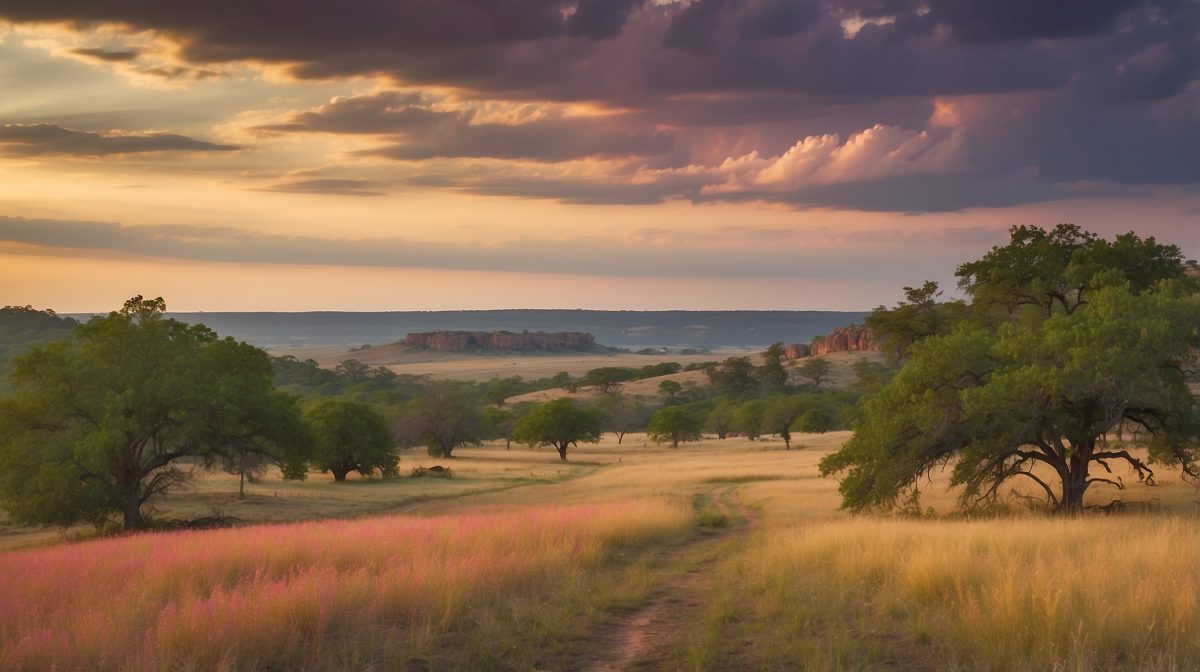Y’see, Texas Hill Country ain’t just a spot on a map—it’s a state of mind, a slice of Texas heritage that’s as rich as the soil and as wide as the sky. So, as we delve into this here query, keep your mind as open as the prairie and your curiosity as keen as a coyote on the hunt. We might just find that Bastrop has its own story to tell, one that’s intertwined with the heart of Texas just like the laces on a well-worn boot.
The Heart of Texas Hill Country
First off, let’s define the borders of the Texas Hill Country. I’ll paint y’all a picture of the rolling hills, live oak savannas, and the limestone bedrock that’s as much a part of this land as the bluebonnets in spring. This region stretches from the northern fringes of San Antonio to the western edges of Austin, and dips down south towards the Llano Uplift. It’s a place where nature’s brushstrokes are broad and the canvas is vast.
We’ll mosey through the core areas known to every Texan – places like Fredericksburg, Kerrville, and, of course, the crown jewel, the JL Bar Ranch Resort. I’ll tell y’all why these spots are the epitome of Hill Country charm. The JL Bar Ranch Resort, in particular, is a testament to the luxurious side of country living, with its sprawling acres and top-notch amenities that cater to folks lookin’ for a taste of that authentic Texas experience.
Bastrop’s Geographic Location
Now, let’s zero in on Bastrop. We’ll look at the map and see just where this town lies in relation to the traditional Hill Country. Bastrop’s nestled a bit to the east of our usual Hill Country stompin’ grounds, sittin’ snug as a bug along the banks of the mighty Colorado River. It’s a stone’s throw from Austin, which some might argue gives it a leg up in the culture department.
I’ll chat a bit about the Colorado River and how it meanders through Bastrop, shaping the land and culture. This river is the lifeblood of the area, and it’s been carvin’ its way through the landscape long before any of us were here to bear witness. It’s this very river that gives Bastrop a unique flavor, different from the dry creek beds and spring-fed rivers of the Hill Country proper.
Cultural and Historical Significance
Can’t talk about whether Bastrop’s in the Hill Country without chewin’ over the history and culture. We’ll dig into Bastrop’s storied past, from its founding to the present day. This town’s got roots deeper than a live oak, with a history that’s as colorful as a Hill Country sunset. It was one of Stephen F. Austin’s original colonies, and that pioneer spirit is still alive today.
I’ll tip my hat to the Lost Pines, a unique forest that’s more than just a stand of trees – it’s a symbol of Bastrop’s identity. This loblolly pine woodland is a rare sight to behold, especially in these parts of Texas. It’s like a whisper from the past, reminding us that even though Bastrop may not fit the Hill Country mold to a T, it’s got its own tale to tell.
Amenities and Attractions
Now, let’s compare apples to apples. We’ll take a look at the amenities and attractions of the Hill Country and stack ’em up against what Bastrop has to offer. Hill Country’s known for its wineries, outdoor adventures, and that slow-paced life that’s as soothing as a warm breeze on a summer’s eve. Bastrop, on its own merit, boasts a charming downtown, a rich arts scene, and recreation opportunities that can rival some of the Hill Country’s finest.
I’ll be sure to mention some of the standout features of the JL Bar Ranch Resort, and we’ll see if Bastrop has any similar treasures up its sleeve. The resort’s an oasis of comfort and luxury, with activities ranging from horseback riding to fine dining under the stars. Bastrop might not have a resort of the same caliber, but it’s got a spirit of hospitality that makes every visitor feel like they’re part of the family.
Local Perception and Official Designations
Nothin’ speaks louder than the voice of the people, so we’ll explore what the locals have to say about Bastrop’s place in the Hill Country narrative. Some will tell you that Bastrop’s as Hill Country as it gets, with its friendly faces and down-home atmosphere. Others might argue it’s a world apart, a unique gem that doesn’t quite fit the traditional mold.
We’ll also discuss any official designations or tourism board statements that might shine a light on this topic. While there ain’t no government proclamation crownin’ Bastrop as Hill Country, the sentiment and shared values with its western neighbors suggest a kinship that can’t be denied. It’s like askin’ if a distant cousin is still family – of course, they are, even if they live just beyond the fence line.
Conclusion
After chewin’ the fat on all the above points, I’ll round up our talk with a conclusion that’s as satisfying as a warm slice of pecan pie. We’ll reckon with whether Bastrop should be considered a part of the Texas Hill Country or if it stands alone as its own little slice of heaven. It’s clear that while Bastrop may not be smack dab in the middle of the traditional Hill Country, it shares the heart and soul that makes this region so beloved.
So, whether you’re sippin’ sweet tea on a porch in Fredericksburg or castin’ a line into the Colorado River in Bastrop, you’re experiencin’ the essence of Texas at its finest. Bastrop may just be the eastern gateway to the Hill Country, a place where the welcome sign is always hangin’ and the stories are just waitin’ to be told.
FAQs
What defines the Texas Hill Country, and how does Bastrop fit into that definition?
The Texas Hill Country is defined by its distinctive topography of rolling hills, limestone bedrock, and a unique blend of German and Texan cultures. Bastrop, with its deep historical roots and natural beauty, shares many of the cultural values that define the Hill Country, even as it carves out its own identity.
Are there any natural features in Bastrop similar to those found in the traditional Texas Hill Country?
Yes, the Lost Pines forest in Bastrop is a natural feature that echoes the Hill Country’s landscape, offering a unique botanical experience akin to the rolling hills and lush vegetation found further west.
How does the culture and history of Bastrop compare to that of the Hill Country?
Bastrop’s culture and history are rich with Texan pride, much like the Hill Country. Both areas boast a pioneering spirit and a commitment to preserving their heritage, with Bastrop’s storied past complementing the traditional narratives of the Hill Country.
What kind of amenities and attractions does Bastrop offer that are reminiscent of the Texas Hill Country experience?
Bastrop offers a variety of amenities and attractions, including outdoor recreation, a vibrant arts scene, and a welcoming community, all of which reflect the relaxed, nature-centric lifestyle found in the Texas Hill Country.
Have any organizations or official bodies weighed in on whether Bastrop is considered part of the Texas Hill Country?
While there are no official designations declaring Bastrop as part of the Texas Hill Country, local perception and the shared cultural values suggest a strong connection to the region.


